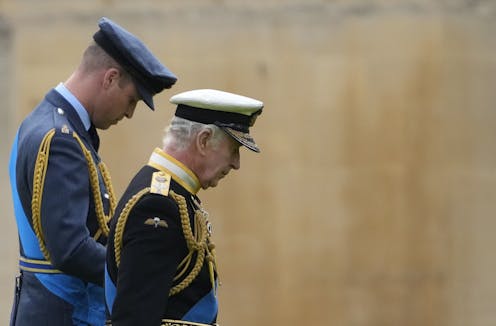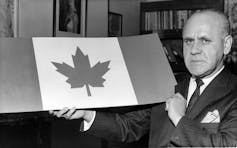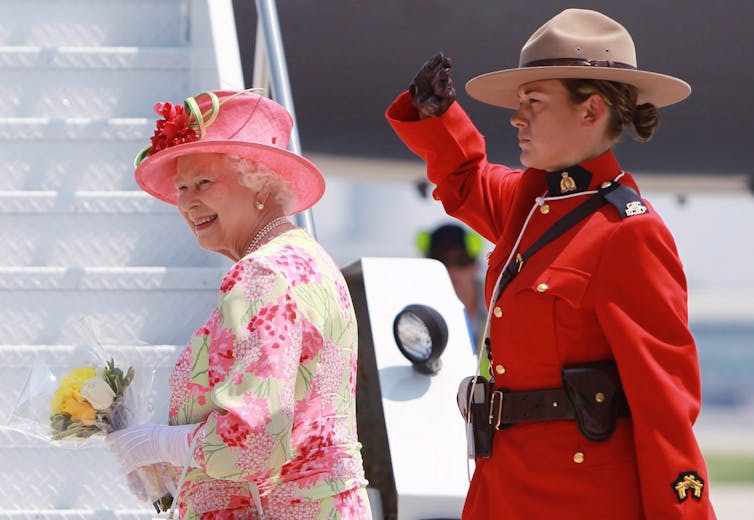
The death of Queen Elizabeth, the reigning monarch of the British Empire, the Commonwealth and therefore Canada, does not create a constitutional crisis in our system of government. It automatically triggered the ascension of King Charles.
Canada, ostensibly an independent country since 1867, now has its first new monarch since 1952. But a lot has changed since then.

In 1982, Canada adopted a newly written Constitution that included the Charter of Rights and Freedoms, the recognition of aboriginal treaty rights and a home-grown means of amending the Constitution in Canada without the involvement of British parliament.
Canada also retired the old red ensign that included the Union Jack and raised the red-and-white flag featuring the maple leaf in 1965. Nonetheless, Canada remains a constitutional monarchy and not a constitutional republic despite these American-style moves toward independence.
Loyal to the British monarchy
Canada’s evolution as a modern state centred on its loyalty to the British Crown, a clear alternative to the American experiment as a democratic republic nearly a century earlier.
The American Revolution was premised on an explicit, violent rejection of the Crown in favour of a presidential form of government. Whatever its problems and failings, it was a great moment of human innovation.
But despite staying loyal to the Crown, Canada would begin to drift away from the old British model 100 years later.
The year 2022 is a possible inflection point as the long reigning and personally popular Queen Elizabeth is succeeded by her less popular eldest son.
For Americans, this may be a celebrity story first and foremost. But for Canadians, Australians, New Zealanders and other citizens of Commonwealth countries, the monarchy is tied to their system of government, symbolic representation and identity.
Cutting ties in the Caribbean
The recent decision by the Caribbean island of Barbados to abandon the monarchy and become a republic likely portends similar outcomes in Jamaica, Antigua and Barbuda and elsewhere in the region.
Even in the U.K., support for the monarchy has been declining for decades, although the majority still support it. According to some sources, younger Britons in particular are losing faith in the monarchy and leaning toward republicanism.
Some commentators suggest with good reason that abandoning the monarchy in Canada would be all but impossible as a constitutional question, though all bets would obviously be off if the U.K. dumped the monarchy first.
While the United States comes to grips with its authoritarian tendencies and the rise of white nationalism, Canada and other Commonwealth countries are increasingly focused on race relations, in particular the role of the Crown in relation to the transatlantic slave trade, imperialism and the treatment of Indigenous Peoples.
These issues all pertain to the historical role of the Crown and the British monarch in the fundamental legitimacy of our states and legal orders. Although Canada didn’t fight a revolutionary war for a republican form of government like the U.S. did, it’s moved closer to an American, republican model of government and further from the British one over the course of its legal, political and constitutional history.
Breaks from the Crown
Canada’s first break with the Crown occurred in 1867 when it became an independent dominion and adopted a division of powers between the founding provinces and the federal Parliament in Ottawa. The second major break was almost 100 years later, when it patriated the Constitution in 1982.
While it’s true Canada retained the British hereditary monarch as its head of state in both 1867 and 1982, that doesn’t mean it has to do the same in the 21st century.
Granted, Canada has not held a referendum on transitioning to a constitutional republic as Australia did in 1999 when citizens opted to maintain ties to the Crown. But the recent decision by Barbados to ditch the monarchy suggests that the global decolonization process is ongoing and that anti-imperial ideology has teeth across the region.
Canadians, Australians and New Zealanders who are the descendants of slaves or Indigenous Peoples have likely been inspired by these developments. Those sentiments will only intensify now that the popular Queen has died.
Canada’s particular reckoning with the role of the Catholic Church, the Church of England and the Crown itself in residential schools and colonial genocide makes the Royal Family’s attributes of continuity and tradition seem like strange reasons to keep them around.
Read more: Not in the past: Colonialism is rooted in the present
Time to reflect on Canada’s future
The death of Queen Elizabeth and the ascension of King Charles should present a moment of reflection for Canada, especially as Caribbean Commonwealth nations begin to abandon the monarchy.
The world admired the Queen. But whatever her personal qualities, it’s time to determine how the monarchy aligns with Canada’s current situation as an independent country and its aspirations for the future, especially if it wants to take itself seriously as a modern, 21st century nation focused on reconciliation with Indigenous Peoples.

As a matter of constitutional law, unanimity of all provincial legislatures and both houses of federal Parliament would be required to remove the monarchy from its place at the heart of our formal and symbolic constitutional order.
It would also likely require a referendum in each province before any of the provincial legislatures or Parliament would take such a vote.
That would be difficult, and probably wouldn’t succeed on the first or even second try, but it’s hardly impossible. Opinion polls suggest that although a majority of Canadians admired the Queen, only about half are in any way committed to the monarchy as an institution.
Younger, more diverse and Indigenous citizens may begin demanding a country in their own image, a country that belongs not only to those who settled it but to those there long before then — and those choosing to make it their home today.
Jeffrey B. Meyers does not work for, consult, own shares in or receive funding from any company or organization that would benefit from this article, and has disclosed no relevant affiliations beyond their academic appointment.
This article was originally published on The Conversation. Read the original article.







